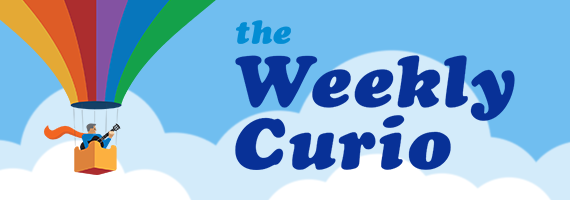Last week's Curios covered the original laugh track, bat bombs, and why humans have chins.
Curio No. 1060 | The easiest way to get a good laugh
Do you ever need a good laugh? In the early days of TV, many shows were taped in front of a live audience. While the crowd made tapings more lively, the actors couldn't always predict when the audience would laugh... and when they wouldn't. So Charles Douglass, a TV sound engineer and ex-Navy radar technician, invented a machine that took the guesswork out of audience reactions. Called the laff box, Douglass' creation looked like a mix between a typewriter and an organ. Each of its 32 color-coded keys activated a tape loop of chuckling, guffaws, or applause; a foot pedal controlled the length of the reaction... keep reading.
Curio No. 1059 | How many close friends do you have? Are you sure?
In 2003, Gallup conducted a poll among Americans that asked, "Not counting your relatives, about how many close friends would you say you have?" The most popular answer was "10 or more." An even larger portion of people were happy with the amount of friends they have, and didn't want more. New research casts some doubts about those responses. A group of data scientists at MIT and Tel Aviv University found that people greatly overestimate the number of friends they have, and that only half of friendships are actually reciprocal. A more realistic number for close friends would be five, at least according to anthropologist Robin Dunbar, who has been studying social relationships for over three decades... keep reading.
Curio No. 1058 | Hacking the wheel of fortune
Betting on roulette is not a very good investment, unless you're J. Doyne Farmer. In the 1970s, Farmer and a group of fellow graduate students at UC Santa Cruz built a computer that could regularly win at casino-grade roulette. It took six years of work and several prototypes, but the team eventually pooled together their math and physics knowledge to beat casinos at their own game. The "casino hack" starts with a data collector, who uses a clicker in his shoe to measure the position and velocity of the ball after it has been released. A computer then processes the input and relays a vibrating signal to the gambler, which encodes the best bet.... keep reading.
Curio No. 1057 | The tech empire built on CDs
Remember those AOL trial CDs? In the mid-'90s, they were everywhere. In the mailbox, hidden in magazines, at the local video rental store. There were thousands of designs, but each disc generally contained the same thing: a free trial to the internet. The discs were part of an aggressive direct marketing campaign to get new subscribers. In 2016, it sounds pretty outdated, but at the time, the campaign worked like a charm. From 1992 to 2002, AOL's subscriber base blossomed from less than 200,000 to 25 million. In total, the company spent over $300 million on discs and, at one point, controlled 50% of the world's production of CDs... keep reading.
Curio No. 1056 | The b-bomb
In 1941, reeling from the attack on Pearl Harbor, the US military was desperate for a retaliation plan. So desperate that they funneled $2 million into the idea of strapping bombs to bats. The idea was that the Air Force would airdrop the bomb-equipped bats just as they were awakening from a forced hibernation. Then they would roost throughout the city and set fire to the paper-and-wood Japanese architecture, causing massive infrastructural damage with "minimal loss of life." The bat bomb, codename "Project X-Ray," was the brainchild of Dr. Lytle Adams, a dentist by trade, who was inspired by a trip to the bat-filled Carlsbad Caverns in New Mexico... keep reading.
Curio No. 1055 | Cheers to that!
The first sip of a drink always goes best with a clink of the glass and a toast. As to why we toast the way we do, the history is muddled. There is an unsubstantiated rumor that glass-clinking began as a way to ensure that one's drink wasn't poisoned. The idea is that by clinking one's glass with another, the drinks would be mixed, thus discouraging secret foes from slipping something into your drink. Another legend claims that the sound of two glasses clinking together wards off evil spirits. As to the word "toast," the origins are a bit clearer. Starting in the 17th century, it became common to add a small piece of spiced toast to wine to sop up the dregs and to add more flavor... keep reading.
Curio No. 1054 | Why humans have chins
Chins: everybody has one. That is, every human has one. Look closer at our animal relatives and you'll notice that we're the only species with a protruding u-shaped thing at the bottom of the face. To some scientists, this poses an evolutionary problem. What, exactly, caused humans to develop chins? The most common hypothesis is that the chin helps us chew more efficiently because the additional bone displaces stress. But analysis shows that the chin is ineffective in this regard--particularly compared to our non-chinned hominid relatives. Another theory is that the chin has something to do with sexual selection and mating.... keep reading.
Want more amusing facts? Check out the archive of 1000+ Daily Curios, or sign-up for Curious.com to get the Daily Curio email delivered right to your inbox!

